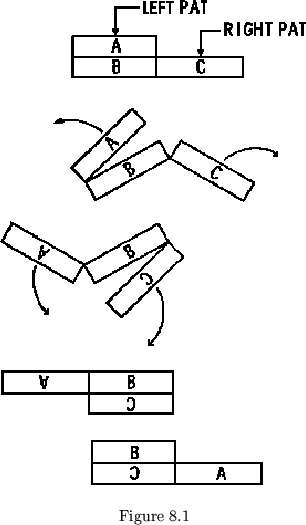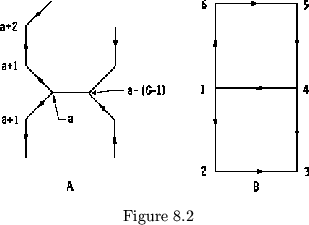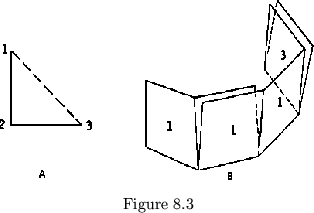The flexing operation, we have seen, requires a thumbhole with
a ![]() hinge. In the case of the proper flexagon, this is the number one
thumbhole. This thumbhole splits the left hand pat into two groups, one
composed of a single subpat and the other composed of
hinge. In the case of the proper flexagon, this is the number one
thumbhole. This thumbhole splits the left hand pat into two groups, one
composed of a single subpat and the other composed of ![]() subpats. The
complete flexing operation inverts the top-most subpat of the left pat,
leaving it on the left side, while it deposits the remaining subpats on
the inverted right pat (see figure 8.1). The number one thumbhole has
been opened out to display the next side. The two new pats are now
joined by what was originally the
subpats. The
complete flexing operation inverts the top-most subpat of the left pat,
leaving it on the left side, while it deposits the remaining subpats on
the inverted right pat (see figure 8.1). The number one thumbhole has
been opened out to display the next side. The two new pats are now
joined by what was originally the ![]() hinge. When the flexagon is rotated,
the hinges must be renumbered. The original
hinge. When the flexagon is rotated,
the hinges must be renumbered. The original ![]() hinge will become the new
hinge will become the new
![]() hinge, and each of the other hinges will have values one lower than
before the flex and rotation. In the normal flexing operation of a proper
flexagon, which has a consecutive subpat hinge sequence and a consecutive
subpat structure, the order of turning up sides must also be consecutive
(as has been shown empirically). This is because each successive
thumbhole is associated with a correspondingly numbered hinge, (i.e. the
hinge, and each of the other hinges will have values one lower than
before the flex and rotation. In the normal flexing operation of a proper
flexagon, which has a consecutive subpat hinge sequence and a consecutive
subpat structure, the order of turning up sides must also be consecutive
(as has been shown empirically). This is because each successive
thumbhole is associated with a correspondingly numbered hinge, (i.e. the
![]() hinge with the number one thumbhole, etc.). Each flexing operation
subtracts one from the value of each hinge, thus bringing the thumbhole
with which any particular hinge is associated closer to the position for
being opened up next. A subpat hinge which in in position
hinge with the number one thumbhole, etc.). Each flexing operation
subtracts one from the value of each hinge, thus bringing the thumbhole
with which any particular hinge is associated closer to the position for
being opened up next. A subpat hinge which in in position ![]() will be
opened after
will be
opened after ![]() flexes and rotations.
flexes and rotations.

If we flex along a given cycle of a flexagon, we notice that we always progress in the same direction, either clockwise or counterclockwise, along the path of the map. If we draw vectors along the edges of the map (indicating in which direction we are progressing), the vectors for a given cycle will always point consistently clockwise or counterclockwise. Whichever way they do point, their direction may be reversed by turning the flexagon over. If a second cycle is added and vectors are drawn on the map, this new cycle will have one vector in common with the first cycle, but the direction of all the vectors around the center of the map polygon representing this cycle will be just opposite from that of the vectors in the first cycle. In fact, the vectors of any map cycle which has one edge in common with any other given cycle will point in the opposite direction with respect to that cycle. This means that all of the polygons in the map of a given flexagon will be oriented; the sense of the orientation may be changed by turning the flexagon over, since in so doing all vectors are reversed.
The reason for the reversed pat structure of a subpat with
respect to its large pat can now be explained. Consider the history
of a proper subpat of a proper flexagon. The pat structure of this
subpat will remain unchanged throughout the flexing operation
(assuming the flexagon flexes left) provided it is in the left pat
and provided it is below thumbhole 1, which has a hinge in the
``1'' position.
This is because a ![]() flex moves all of the subpats which are
below
thumbhole 1 from the left pat to the right pat, unchanged in any way
(i.e. uninverted). However, if this subpat is on the top of the left
pat, and the flexagon is flexed, the subpat will remain in the left
pat but will be inverted. A rotation and flex will reinvert it and
place
flex moves all of the subpats which are
below
thumbhole 1 from the left pat to the right pat, unchanged in any way
(i.e. uninverted). However, if this subpat is on the top of the left
pat, and the flexagon is flexed, the subpat will remain in the left
pat but will be inverted. A rotation and flex will reinvert it and
place ![]() subpats on top of it, leaving it undisturbed for
subpats on top of it, leaving it undisturbed for ![]() flexes
thereafter. However, if we decide not to rotate, but to flex along
a new cycle, this subpat alone will remain in the left hand pat. As
the flexagon must always flex left (we built it that way), the first
flexing operation will open up the first thumbhole to a side,
flexes
thereafter. However, if we decide not to rotate, but to flex along
a new cycle, this subpat alone will remain in the left hand pat. As
the flexagon must always flex left (we built it that way), the first
flexing operation will open up the first thumbhole to a side, ![]() ,
the last side up being (a) if the flexing was proceeding in an ascending
order around the map (see figure 8.2a). For instance, in an order
6 tetraflexagon as shown in figure 8.2b, if we flex from 1
to 2 to 3 to 4 to 1, and then decide to change over to a new
cycle, we must flex next to side 6. Although the numbering of the
map is still counterclockwise, the
flexing vectors have changed direction, and the flexing must proceed against
the numbering. In order for the side following side (a) to be side
,
the last side up being (a) if the flexing was proceeding in an ascending
order around the map (see figure 8.2a). For instance, in an order
6 tetraflexagon as shown in figure 8.2b, if we flex from 1
to 2 to 3 to 4 to 1, and then decide to change over to a new
cycle, we must flex next to side 6. Although the numbering of the
map is still counterclockwise, the
flexing vectors have changed direction, and the flexing must proceed against
the numbering. In order for the side following side (a) to be side
![]() , the
, the ![]() thumbhole must be the lowest thumbhole in the subpat containing the new
cycle, for that subpat will be inverted, making the
thumbhole must be the lowest thumbhole in the subpat containing the new
cycle, for that subpat will be inverted, making the ![]() thumbhole the
top most one when the subpat is left along in the left pat.
Similarly, in flexing
about the second cycle (assuming there are no other cycles attached to the
second one)
thumbhole the
top most one when the subpat is left along in the left pat.
Similarly, in flexing
about the second cycle (assuming there are no other cycles attached to the
second one) ![]() will follow
will follow ![]() and will in turn be followed by
and will in turn be followed by
![]() ,
and so on until
,
and so on until ![]() is reached. Since side
is reached. Since side
![]() used the first thumbhole in the subpat, sides
used the first thumbhole in the subpat, sides ![]() through
through ![]() must use the others in order,
and when the subpat constant order is inverted by the subpat's incorporation
into the large pat,
must use the others in order,
and when the subpat constant order is inverted by the subpat's incorporation
into the large pat, ![]() will be the side nearest the top. Since each
thumbhole in a subpat can be associated with a single leaf, the thumbhole
order
becomes reversed also. Since the basic number sequence must increase
consecutively when
read down the pat, the pat structure for the subpat must be inverted
with respect to the large pat.
will be the side nearest the top. Since each
thumbhole in a subpat can be associated with a single leaf, the thumbhole
order
becomes reversed also. Since the basic number sequence must increase
consecutively when
read down the pat, the pat structure for the subpat must be inverted
with respect to the large pat.

Since we are on the subject of flexing operation, let us consider
flexing operations other than the ![]() flex; i.e., the tubulations. For all
proper flexagons, the
flex; i.e., the tubulations. For all
proper flexagons, the
![]() flexes
remove all but
flexes
remove all but
![]() leaves respectively from the left pat and deposit them from the right
pat; As has been stated before, a
tubulation acts like a flex. For instance, in a tetraflexagon of order
3 (see figure 8.3a) which has a tubulation
from 1 to 3, we can 1 flex from face
leaves respectively from the left pat and deposit them from the right
pat; As has been stated before, a
tubulation acts like a flex. For instance, in a tetraflexagon of order
3 (see figure 8.3a) which has a tubulation
from 1 to 3, we can 1 flex from face
![]() to face
to face ![]() and when we tubulate,
we can cut the hinge and lay the flexagon
out in the form of a straight strip of
squares with one on the top and three on the bottom. This, then, is
face
and when we tubulate,
we can cut the hinge and lay the flexagon
out in the form of a straight strip of
squares with one on the top and three on the bottom. This, then, is
face ![]() (see figure 8.3b). When we want to flex from face
(see figure 8.3b). When we want to flex from face ![]() back to
back to
![]() , we fold the three's so that they face each other and tape the cut
hinge back together. The flexagon will now open up to side 2. We should
notice, however, that this process of turning the tubulation in side out
has also exchanged the position of the two pats of a unit with respect
to each other. This is equivalent to a rotation so in this operation,
we have both flexed and rotated.
, we fold the three's so that they face each other and tape the cut
hinge back together. The flexagon will now open up to side 2. We should
notice, however, that this process of turning the tubulation in side out
has also exchanged the position of the two pats of a unit with respect
to each other. This is equivalent to a rotation so in this operation,
we have both flexed and rotated.
